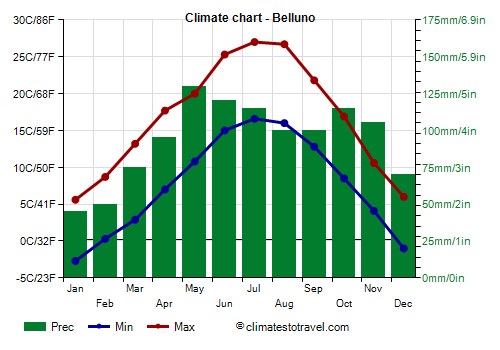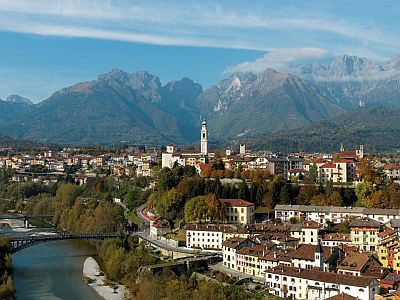Select units of measurement for the temperature and rainfall tables (metric or imperial).
Average weather, temperature, rainfall, sunshine hours

The climate of Belluno is
moderately continental, with cold winters and warm summers. Rainfall is abundant in summer and autumn, while winter is the relatively driest season. In winter it can snow.
The city is located in the Veneto region, in a valley crossed by the Piave river, at 46 degrees north latitude and at an altitude of 350-400 metres (1,150-1,300 feet).
To the west is the Dolomiti Bellunesi National Park, while to the north and east are the Prealps of Belluno, as well as Lake Santa Croce and the plateau of Cansiglio.

The
winter, from December to February, is cold. Cold air stagnates in the valley, which is why the minimum temperatures often drop below freezing.
In the last decades of the twentieth century, with a minimum of -4 °C (25 °F) and a maximum of -3 °C (26.5 °F), Belluno was the only Italian provincial capital to have an average January temperature below 0 °C (32 °F).
Snow in Belluno is more abundant than in the cities of the Venetian plain. On average, 30 cm (12 in) of snow fall per year. In January 1985, the snow reached 60 cm (23.5 in) in height. In Feltre, in the southern part of the valley, it snows more.
Summer, from June to August, but temperatures are lower than in the plains.
Sometimes, an Atlantic front, able to bring cool and rainy weather, can affect this area even in summer; more often, on sunny days, thunderstorms can erupt in the afternoon or evening.
During
heat waves, which are becoming increasingly more frequent, the temperature can reach or exceed 35 °C (95 °F).
Best Time
Belluno can be visited from May to September, although it must be said that it is the rainiest period of the year. Sometimes, from mid-June to the end of August, it can get very hot, though less than at sea level.
Belluno - Climate data
In Belluno, the
average temperature of the coldest month (January) is of
1.4 °C, that of the warmest month (July) is of
21.8 °C. Here are the average temperatures.
Belluno - Average temperatures (2014-2020) |
| Month | Min | Max | Mean |
|---|
| January | -2.7 | 5.6 | 1.4 |
|---|
| February | 0.3 | 8.7 | 4.5 |
|---|
| March | 2.9 | 13.2 | 8 |
|---|
| April | 7 | 17.7 | 12.4 |
|---|
| May | 10.8 | 20 | 15.4 |
|---|
| June | 15 | 25.3 | 20.2 |
|---|
| July | 16.6 | 27 | 21.8 |
|---|
| August | 16 | 26.7 | 21.4 |
|---|
| September | 12.8 | 21.8 | 17.3 |
|---|
| October | 8.5 | 16.9 | 12.7 |
|---|
| November | 4.1 | 10.6 | 7.4 |
|---|
| December | -1 | 6 | 2.5 |
|---|
| Year | 7.6 | 16.7 | 12.1 |
|---|
amounts to
1130 millimeters per year: it is therefore quite abundant. It ranges from
45 millimeters in the driest month (January) to
130 millimeters in the wettest one (May). Here is the average precipitation.
Belluno - Average precipitation| Month | Days |
|---|
| January | 45 | 5 |
|---|
| February | 50 | 5 |
|---|
| March | 75 | 7 |
|---|
| April | 95 | 11 |
|---|
| May | 130 | 13 |
|---|
| June | 120 | 13 |
|---|
| July | 115 | 11 |
|---|
| August | 100 | 10 |
|---|
| September | 100 | 8 |
|---|
| October | 115 | 9 |
|---|
| November | 105 | 8 |
|---|
| December | 70 | 6 |
|---|
| Year | 1130 | 106 |
|---|